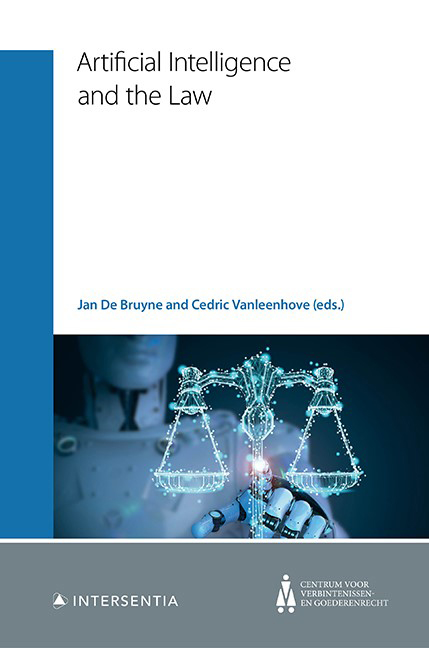Book contents
- Frontmatter
- Contents
- Foreword
- Contributing Authors
- Chapter 1 Basic Concepts of AI for Legal Scholars
- Chapter 2 Different Models of Innovation and Their Relation to Law
- Chapter 3 Setting the Scene: On AI Ethics and Regulation
- Chapter 4 Quantitative Legal Prediction: the Future of Dispute Resolution?
- Chapter 5 AI Arbitrators … ‘Does Not Compute’
- Chapter 6 AI through a Human Rights Lens. The Role of Human Rights in Fulfilling AI’s Potential
- Chapter 7 Killer Robots: Lethal Autonomous Weapons and International Law
- Chapter 8 AI and Data Protection: the Case of Smart Home Assistants
- Chapter 9 AI and IP: a Tale of Two Acronyms
- Chapter 10 Tax and Robots
- Chapter 11 Robotisation and Labour Law. The Dark Factory: the Dark Side of Work?
- Chapter 12 The Hypothesis of Technological Unemployment Caused by AI-Driven Automation and its Impact on Social Security Law
- Chapter 13 AI in Belgian Contract Law: Disruptive Challenge or Business as Usual?
- Chapter 14 Tort Law and Damage Caused by AI Systems
- Chapter 15 Insurance Underwriting on the Basis of Telematics: Segmentation and Profiling
- Chapter 16 AI and Creditworthiness Assessments: the Tale of Credit Scoring and Consumer Protection. A Story with a Happy Ending?
- Chapter 17 AI and the Consumer
- Chapter 18 Robots and AI in the Healthcare Sector: Potential Existing Legal Safeguards Against a(n) (Un)justified Fear for ‘Dehumanisation’ of the Physician-Patient Relationship
Chapter 14 - Tort Law and Damage Caused by AI Systems
Published online by Cambridge University Press: 26 May 2021
- Frontmatter
- Contents
- Foreword
- Contributing Authors
- Chapter 1 Basic Concepts of AI for Legal Scholars
- Chapter 2 Different Models of Innovation and Their Relation to Law
- Chapter 3 Setting the Scene: On AI Ethics and Regulation
- Chapter 4 Quantitative Legal Prediction: the Future of Dispute Resolution?
- Chapter 5 AI Arbitrators … ‘Does Not Compute’
- Chapter 6 AI through a Human Rights Lens. The Role of Human Rights in Fulfilling AI’s Potential
- Chapter 7 Killer Robots: Lethal Autonomous Weapons and International Law
- Chapter 8 AI and Data Protection: the Case of Smart Home Assistants
- Chapter 9 AI and IP: a Tale of Two Acronyms
- Chapter 10 Tax and Robots
- Chapter 11 Robotisation and Labour Law. The Dark Factory: the Dark Side of Work?
- Chapter 12 The Hypothesis of Technological Unemployment Caused by AI-Driven Automation and its Impact on Social Security Law
- Chapter 13 AI in Belgian Contract Law: Disruptive Challenge or Business as Usual?
- Chapter 14 Tort Law and Damage Caused by AI Systems
- Chapter 15 Insurance Underwriting on the Basis of Telematics: Segmentation and Profiling
- Chapter 16 AI and Creditworthiness Assessments: the Tale of Credit Scoring and Consumer Protection. A Story with a Happy Ending?
- Chapter 17 AI and the Consumer
- Chapter 18 Robots and AI in the Healthcare Sector: Potential Existing Legal Safeguards Against a(n) (Un)justified Fear for ‘Dehumanisation’ of the Physician-Patient Relationship
Summary
INTRODUCTION
1. Artificial intelligence is becoming increasingly important in our daily professional and social lives. Although the use of AI systems has many benefits for a variety of sectors, different legal challenges remain. Some of these challenges are extensively discussed in this book. In this chapter, we will focus on the application of liability for damage caused by AI systems. The importance of liability and AI systems has already been mentioned in several recent documents issued by the European Union (EU). The White Paper on Artificial Intelligence, for instance, stresses that the main risks related to the use of AI concern the application of rules designed to protect fundamental rights as well as safety and liability-related issues. Scholars have also concluded that ‘[l]iability certainly represents one of the most relevant and recurring themes’ when it comes to AI systems.
2. This emphasis on liability is not surprising considering that AI systems will increasingly cause damage. Reference can be made to recent accidents involving autonomous vehicles. The autopilot of a Tesla car, for instance, was not able to distinguish a white tractor-trailer crossing the road from the bright sky above, leading to a fatal crash. A self-driving Uber car recently hit a pedestrian in Arizona. The woman later died in the hospital. A robot also attacked and injured a man at a tech fair in China. A surgical robot at a hospital in Philadelphia malfunctioned during a prostate surgery, thereby severely injuring the patient. In February 2015, a South Korean woman was sleeping on the floor when her robot vacuum ‘ate’ her hair forcing her to call for emergency help.
These examples show that accidents may happen despite optimising national and supranational safety rules for AI. This is when questions of liability become important. Nevertheless, the application of liability regimes for damage caused by AI systems can be challenging. The characteristics of AI systems such as opaqueness, autonomy, connectivity, data dependency or self-learning abilities make it difficult to trace back potentially problematic decisions made with the involvement of such systems.
- Type
- Chapter
- Information
- Artificial Intelligence and the Law , pp. 359 - 404Publisher: IntersentiaPrint publication year: 2021



